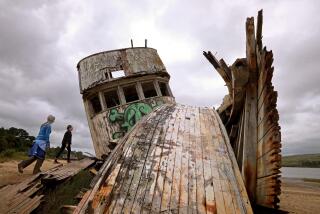Seattle museum gives its visitors waves of boats : Center for Wooden Boats offers a hands-on experience with vessels from the past.
SEATTLE — In these hypersensitive times, we seldom find a place to gather and celebrate something about “American culture” that is shared by virtually all of our diverse, wary, squabbling cultural constituencies.
Which is one of about a dozen reasons why Seattle and enthusiasts across the nation treasure Dick Wagner and his vest-pocket “living museum,” the Center for Wooden Boats.
No matter whether your ancestors arrived by the slave trade, over the Bering Strait land bridge or on the Mayflower; whether you rumbled up from Baja two weeks ago in a truck or touched down at LAX in a jet from the Far East, it is likely--no, it is all but a certainty--that small boats of some sort figure in the traditions of your culture.
“The most common thread in our history is our maritime tradition, and the most common maritime heritage is that of small craft,” said Wagner, a droll, sunburned, energetic man of 63 who long ago found his life consumed by this passion.
Yet nowhere else in America except for right here on the south shore of glorious, pint-sized, rag-tag Lake Union, under the skyline of downtown Seattle, is there such a museum as this. On any given day, perhaps half of the center’s 150 historical craft are floating on a cramped dock.
It costs nothing to come see. About 50,000 Americans do so each year. And for a few bucks an hour, you can cast off in the boat of your choosing and row or sail around this busy, colorful lake, about half a mile square. You will share the scene with colonies of houseboaters, floatplanes from scheduled airlines, yachts, fishing trawlers, tugboats, tramp freighters, boat yards, yuppie restaurants, rusty corrugated-metal boathouses, ducks, geese, kayakers and probably a golden retriever or two.
“This is a museum where people are encouraged to learn by doing. You can play with the exhibits. Or, in one of our boat-building classes, you can build an exhibit,” Wagner said.
Groups of disadvantaged youths attend classes here to learn math, history, science, vocabulary, teamwork and leadership the old-fashioned way, the seafaring way. Well-dressed travelers from across the country arrive with worn press clippings from boating magazines or Sports Illustrated.
And that stooped man in a flannel shirt down on the dock the other afternoon was Norm Blanchard Jr., off for a nostalgic sail in one of the classic sloops he designed and built on Lake Union half a century ago.
Families of tourists walking the docks on recent weekends found themselves welcomed aboard for a joy ride in a mahogany replica of a 1929 triple-cockpit runabout, touring the lake and its latest attraction: the houseboat used as the set for the movie “Sleepless in Seattle.”
Among other craft--some of which can be rented and some of which are too delicate or decayed--are Indian dugout canoes, a Bangladesh rice boat, a Danish Faroe Island boat, an Eskimo kayak, a turn-of-the-century Alaskan gill-netter, a 1913 Monterey Clipper, a 1096 steam launch--plus here and there a pea pod, a Whitehall, some Bettle Cats, a 1939 Herreshoff 12 1/2 sloop and on and on.
Some gleam with finished brightwork; many are scuffed, peeling and worn. Boats, after all, are built to be used, or so they still believe at the Center for Wooden Boats.
Yes, there are other and larger maritime museums in the United States--at Mystic Seaport in Connecticut and the Maritime National Historical Park in San Francisco. But experts such as Bill Doll, small boat curator at the San Francisco historical park, say there is no other established museum in the country like Seattle’s, devoted solely to small craft and where visitors can use the exhibits and attend seminars.
For locals, the Center for Wooden Boats also serves as a coffee shop, library, meeting hall and mooch-a-beer-in-the-afternoon hangout, just as it did back in 1967 when friends used to drop by Wagner’s houseboat on the lake and dink around in his small livery of restored boats.
Wagner was an architect back then--a job that he soon found he had no time for. Today, his achievement has grown larger than just one man. A board of directors oversees the $200,000 annual budget, a staff of five and a membership of about 2,000 local residents.
Still, some people suspect Wagner is having a little too much fun.
A few years ago, he applied for a federal operating grant from the Institute for Museum Services. Twice he was turned down. Fellow museum curators toured the center disapprovingly. History, they concluded, was not something to be played with.
Wagner could not help but wonder, why not?
More to Read
Sign up for The Wild
We’ll help you find the best places to hike, bike and run, as well as the perfect silent spots for meditation and yoga.
You may occasionally receive promotional content from the Los Angeles Times.






